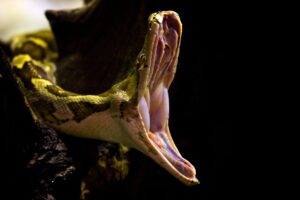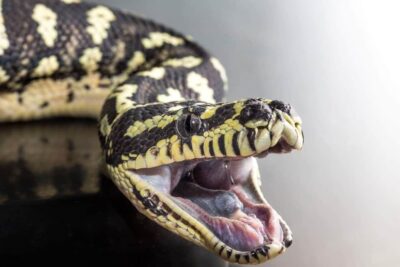Fangs and venom are often associated with venomous snakes, but it’s important to understand the distinction between the two:
- Fangs: Fangs are specialized teeth or tooth-like structures that are adapted for injecting venom into prey or predators. These fangs are typically long, hollow, and sharply pointed. Venomous snakes use their fangs to deliver venom into the body of their prey or as a defensive mechanism against potential threats.
- Venom: Venom is a toxic secretion produced by specialized glands in the snake’s head. It contains a variety of proteins and enzymes that can immobilize prey, aid in digestion, or act as a defense mechanism. Venomous snakes inject venom into their prey through their fangs, causing a range of effects depending on the specific composition of the venom and the species being targeted.
Non-venomous snakes, like ball pythons, do not possess fangs designed for injecting venom. Instead, they have rows of small, recurved teeth that are used for grasping and holding onto prey. These snakes typically kill their prey through constriction rather than envenomation.
Understanding the difference between fangs and venom is crucial for accurately identifying and classifying different snake species and understanding their hunting and defense mechanisms.
Fang Care and Safety Tips for Ball Python Owners

While ball pythons don’t possess fangs like venomous snakes, their teeth still require care and consideration for the safety of both the snake and its owner. Here are some fang care and safety tips for ball python owners:
- Regular Health Checks: Monitor your ball python’s oral health regularly. Look for signs of dental issues such as broken or damaged teeth, mouth rot, or retained shed on the teeth. If you notice any abnormalities, consult with a veterinarian who specializes in reptiles.
- Provide Proper Enclosure: Ensure that your ball python’s enclosure is secure and appropriately sized to prevent escape attempts. This helps minimize stress and reduces the risk of injury to both the snake and its owner.
- Handle with Care: When handling your ball python, be gentle and avoid sudden movements that may startle or stress the snake. Support its body properly to prevent it from feeling insecure or defensive, which could lead to defensive bites.
- Avoid Aggressive Handling: While ball pythons are generally docile, they may bite if they feel threatened or stressed. Avoid handling your snake excessively, especially during feeding, shedding, or when it’s in a defensive posture.
- Proper Feeding Technique: When offering food to your ball python, use feeding tongs or appropriate feeding tools to prevent accidental bites. Avoid hand-feeding, as this may cause the snake to associate your hand with food and increase the risk of accidental bites.
- Training and Socialization: Spend time with your ball python to help it become accustomed to your presence and handling. Gentle, consistent handling can help build trust between you and your snake, reducing the likelihood of defensive behavior.
- Seek Professional Help: If your ball python exhibits aggressive or defensive behavior, or if you’re unsure how to handle a particular situation safely, seek guidance from experienced reptile handlers or a qualified reptile veterinarian.
By following these fang care and safety tips, you can help ensure a positive and safe experience for both you and your ball python. Remember that understanding and respecting your snake’s behavior and needs are essential for maintaining a healthy and happy pet.
How ball pythons use their teeth
Ball pythons, like other non-venomous snakes, use their teeth primarily for grasping and holding onto prey during feeding. Here’s how they use their teeth:
- Capturing Prey: Ball pythons typically hunt by ambushing their prey. When they detect prey nearby, they strike quickly and seize it with their teeth. Their teeth are sharp and recurved, allowing them to effectively grasp onto their prey.
- Constriction: Once a ball python has captured its prey, it begins the process of constriction. The snake coils its body around the prey and tightens its grip, using its teeth to anchor itself and prevent the prey from escaping.
- Swallowing: After the prey has been subdued, the ball python begins to swallow it whole. The teeth play a crucial role in guiding the prey into the snake’s mouth and preventing it from slipping out during swallowing.
- Defense: While ball pythons are generally docile, they may use their teeth defensively if they feel threatened or cornered. In such situations, they may open their mouths and display their teeth as a warning to potential predators or aggressors.
Overall, the teeth of ball pythons are essential for capturing, subduing, and consuming prey, as well as for defensive purposes when necessary. However, it’s important to note that ball pythons are not aggressive snakes and will typically only bite in self-defense if they feel threatened. With proper handling and care, the risk of being bitten by a ball python is minimal.
Conclusion
All the information on this page is centered on answering the question do ball pythons have fangs. Ball pythons do not have fangs. Instead, they possess rows of small, recurved teeth used for grasping, constricting prey, and swallowing.
Unlike venomous snakes, ball pythons lack specialized fangs for injecting venom. While their teeth are essential for hunting and defensive purposes, they are not adapted for delivering venom. Therefore, it can be affirmed that ball pythons do not have fangs.



